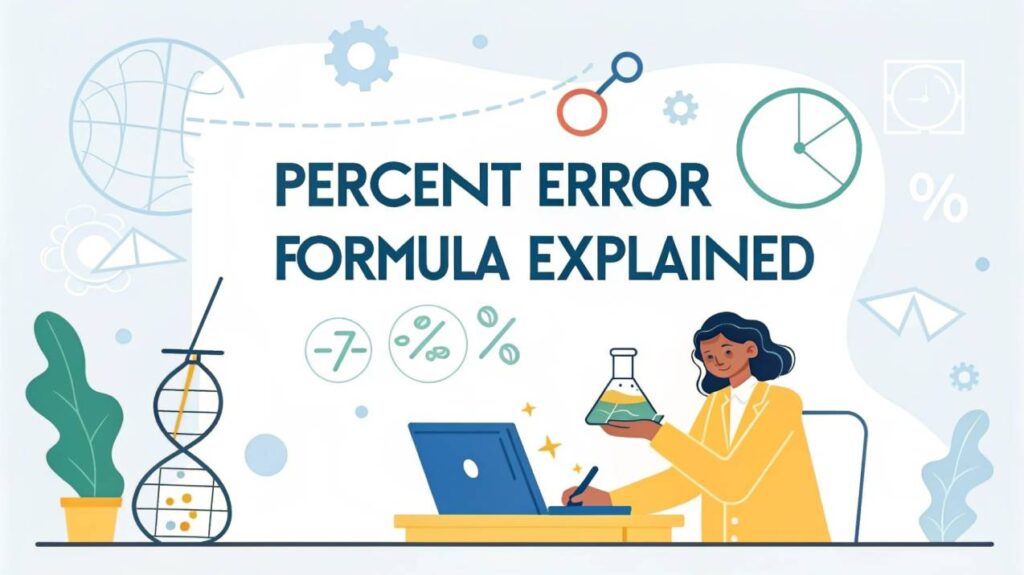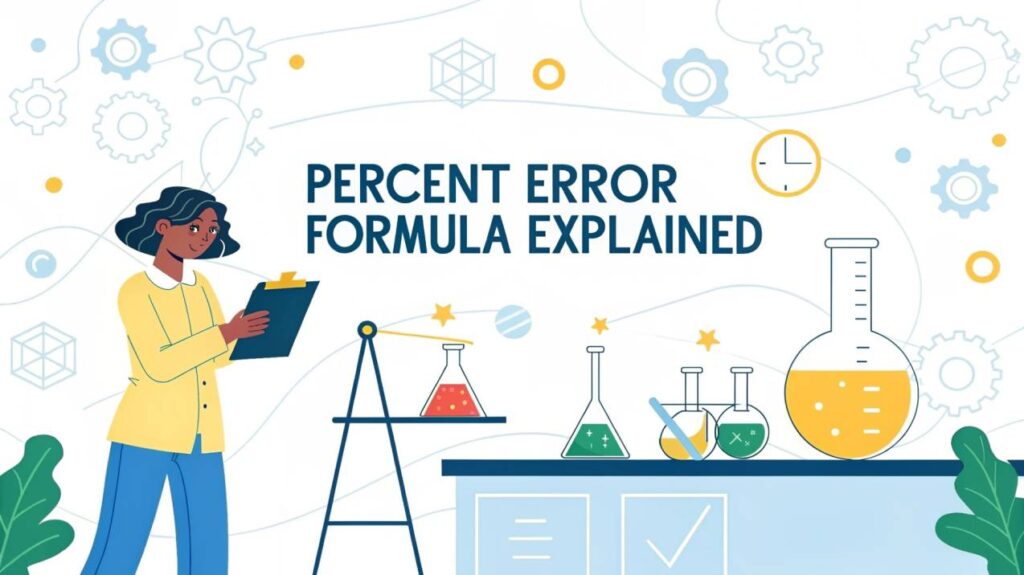When conducting experiments, making measurements, or analyzing data, accuracy is crucial. Whether you’re a student working on a chemistry lab report or an engineer testing product specifications, understanding how to calculate and interpret percent error is essential. The percent error formula provides a standardized way to measure how close your experimental results are to the true or accepted values.

In this comprehensive guide, we’ll break down everything you need to know about the percent error formula, from basic definitions to real-world applications. You’ll learn step-by-step calculation methods, see worked examples, and discover why this concept is so important across various fields.
Table of Contents
What is Percent Error?
Percent error is a measure of accuracy that compares an experimental or measured value to the true, accepted, or theoretical value. It expresses the difference between these values as a percentage, making it easy to understand the magnitude of error regardless of the units or scale of measurement.
Also Read — CRS Score Calculator
Think of percent error as a way to answer the question: “How far off was my measurement?” The smaller the percent error, the more accurate your measurement or experiment was. Conversely, a larger percent error indicates greater deviation from the expected result.
Key Components:
- Experimental Value (Measured Value): The result you obtained from your experiment or measurement
- True Value (Accepted Value): The known, correct, or theoretical value
- Error: The difference between experimental and true values
The Percent Error Formula
The percent error formula is straightforward and universally applicable across scientific disciplines:
Percent Error=[(Experimental Value – True Value)/True Value]×100
Let’s break down each component:
- |Experimental Value – True Value|: The absolute value of the difference ensures we always get a positive result
- True Value: The denominator standardizes the error relative to the expected value
- × 100: Converts the decimal result to a percentage
Alternative Formula Representation:
Some textbooks present the formula as:
Percent Error = (|Observed Value – Expected Value| / Expected Value) × 100
Both representations are identical and can be used interchangeably.
Also Read — How to Type Enye in Keyboard
Steps to Calculate Percent Error Formula
Follow these five simple steps to calculate percent error accurately:
Step 1: Identify Your Values
- Determine the experimental (measured) value
- Identify the true (accepted or theoretical) value
Step 2: Calculate the Difference
- Subtract the true value from the experimental value
- Example: Experimental Value – True Value
Step 3: Apply Absolute Value
- Take the absolute value of the difference to eliminate negative signs
- This ensures percent error is always expressed as a positive percentage
Step 4: Divide by True Value
- Divide the absolute difference by the true value
- This normalizes the error relative to the expected value
Step 5: Convert to Percentage
- Multiply the result by 100 to express as a percentage
- Round to an appropriate number of significant figures
Worked Examples
Example 1: Physics Measurement
Scenario: A student measures the acceleration due to gravity and gets 9.72 m/s². The accepted value is 9.81 m/s².
Solution:
- Experimental Value = 9.72 m/s²
- True Value = 9.81 m/s²
- Difference = |9.72 – 9.81| = |-0.09| = 0.09
- Percent Error = (0.09 / 9.81) × 100 = 0.92%
Interpretation: The measurement has less than 1% error, indicating high accuracy.
Example 2: Chemistry Experiment
Scenario: In a titration experiment, a student determines the concentration of a solution to be 0.245 M. The actual concentration is 0.250 M.
Solution:
- Experimental Value = 0.245 M
- True Value = 0.250 M
- Difference = |0.245 – 0.250| = 0.005
- Percent Error = (0.005 / 0.250) × 100 = 2.0%
Interpretation: A 2% error is generally acceptable in analytical chemistry.
Example 3: Real-Life Scenario
Scenario: A digital scale shows your weight as 68.5 kg, but a calibrated medical scale reads 70.0 kg.
Solution:
- Experimental Value = 68.5 kg
- True Value = 70.0 kg
- Difference = |68.5 – 70.0| = 1.5
- Percent Error = (1.5 / 70.0) × 100 = 2.14%
Interpretation: Your home scale has approximately 2% error compared to the medical standard.
Also Read — UCAS Points Calculator
Why is Percent Error Important?
Scientific Accuracy
Percent error helps scientists and researchers evaluate the reliability of their experimental methods and instruments. It provides a standardized metric for comparing accuracy across different experiments and scales.
Quality Control
In manufacturing and engineering, percent error calculations help maintain product quality by identifying when measurements or processes deviate from specifications.
Educational Assessment
Teachers use percent error to help students understand measurement uncertainty and develop critical thinking about experimental results.
Research Validation
Percent error helps determine whether experimental results support or contradict theoretical predictions, guiding future research directions.
Percent Error vs Percent Difference
Many students confuse percent error with percent difference. Here’s a clear comparison:
| Aspect | Percent Error | Percent Difference |
|---|---|---|
| Purpose | Compares an experimental value to a true or accepted value | Compares two experimental or measured values |
| Reference | Uses the accepted/theoretical value as the benchmark | No single reference value—uses the average of the two values |
| Formula | (\text{Percent Error} = \frac{ | \text{Experimental – True} |
| Application | Evaluates accuracy (how close you are to the correct value) | Evaluates precision (how close two results are to each other) |
Simple Way to Remember
- Percent Error → Accuracy → “Am I close to the right answer?”
- Percent Difference → Precision → “Are my two measurements consistent with each other?”
👉 For example:
- In a chemistry lab, if you compare your calculated density to the accepted density, you use percent error.
- If you compare the results of two different thermometers measuring the same temperature, you use percent difference.

When to Use Each:
- Use percent error when you have a known, accepted value for comparison
- Use percent difference when comparing two experimental measurements of equal validity
Common Mistakes to Avoid
Forgetting Absolute Value
Mistake: Calculating percent error without absolute value signs Result: Negative percent error values Solution: Always use absolute value to ensure positive results
Wrong Reference Value
Mistake: Using experimental value as denominator Correct Approach: Always use the true/accepted value as the denominator
Significant Figures
Mistake: Reporting percent error with too many decimal places Solution: Round to match the precision of your original measurements
Misinterpreting Results
Mistake: Assuming all percent error is “bad” Reality: Some error is expected; focus on whether it’s within acceptable limits
What is a Good Percent Error?
The acceptability of percent error depends on the context:
- 0-2%: Excellent accuracy for most laboratory work
- 2-5%: Good accuracy, acceptable for many applications
- 5-10%: Fair accuracy, may need method improvement
- >10%: Poor accuracy, requires investigation
Field-Specific Standards:
- Analytical Chemistry: Often requires <1% error
- Physics Labs: 2-5% is typically acceptable
- Engineering: Varies by application and safety requirements
- Medical Devices: Often requires <0.1% error for critical measurements
How to Reduce Percent Error
Improve Measurement Techniques
- Use more precise instruments
- Take multiple measurements and calculate averages
- Calibrate equipment regularly
- Control environmental factors
Minimize Systematic Errors
- Identify and correct consistent biases
- Use proper experimental procedures
- Account for known sources of error
Reduce Random Errors
- Increase sample size
- Improve measurement consistency
- Use statistical analysis techniques
Percent Error in Different Fields
Chemistry Applications
- Determining purity of compounds
- Validating analytical methods
- Comparing experimental yields to theoretical predictions
Physics Applications
- Verifying fundamental constants
- Testing theoretical models
- Calibrating instruments
Engineering Applications
- Quality control in manufacturing
- Testing material properties
- Validating design specifications
Biology and Medicine
- Comparing experimental results to established values
- Validating diagnostic test accuracy
- Monitoring treatment effectiveness
Conclusion
The percent error formula is an essential tool for evaluating measurement accuracy across scientific, engineering, and everyday applications. By following the simple five-step process—identify values, calculate difference, apply absolute value, divide by true value, and multiply by 100—you can quickly assess how close your results are to expected values.
Remember that some error is normal and expected in any measurement process. The key is understanding what level of percent error is acceptable for your specific application and taking steps to minimize error when necessary. Whether you’re conducting chemistry experiments, physics labs, or quality control testing, mastering the percent error formula will help you evaluate and improve your measurement accuracy.
Practice with different examples, pay attention to significant figures, and always interpret your results in the context of your specific field or application. With consistent use, calculating and interpreting percent error will become second nature, making you a more effective scientist, engineer, or analyst.
Frequently Asked Questions
Can Percent Error Be Negative?
No, percent error should always be positive because we use absolute value in the calculation. If you’re getting negative values, check that you’re applying the absolute value correctly.
What Does 0% Error Mean?
Zero percent error means your experimental value exactly matches the true value. While theoretically possible, this is rare in practice due to measurement limitations.
How to Minimize Percentage Error?
Reducing percentage error is crucial for obtaining reliable, accurate results in any measurement or experimental process. Here are comprehensive strategies organized by error type and application:
Real-World Applications of Percent Error
Percent error calculations are fundamental across numerous industries and fields. Understanding these applications helps appreciate why accuracy matters:
What is Absolute Error?
Absolute error is the foundation for understanding all other error measurements, including percent error. It represents the simplest way to quantify measurement accuracy.







